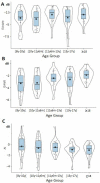The Magnitude of Contralateral Suppression of Otoacoustic Emissions Is Ear- and Age-Dependent
- PMID: 37445587
- PMCID: PMC10342437
- DOI: 10.3390/jcm12134553
The Magnitude of Contralateral Suppression of Otoacoustic Emissions Is Ear- and Age-Dependent
Abstract
The maturation of the uncrossed medial olivocochlear (UMOC) efferent remains poorly documented to date. The UMOC efferent system allows listeners to not only detect but also to process, recognize, and discriminate auditory stimuli. Its fibers can be explored non-invasively by recording the effect of contralateral acoustic stimulation (CAS), resulting in a decrease in the amplitude of transient evoked otoacoustic emissions (TEOAE). The objective of the present cross-sectional study was to investigate how the effectiveness of this system varies with age in healthy subjects aged 8 years to adulthood. For this purpose, 120 right-handed native French-speaking subjects (57 females and 63 males) were divided into five age groups of 24 subjects each: 8y-10y, 10y-11y6m, 11y6m-13y, 13y-17y, and ≥18y. TEOAE amplitudes with and without CAS were recorded. The equivalent attenuation (EA) was calculated, corresponding to the change in TEOAE amplitude equivalent to the effect generated by CAS. General linear models were performed to control for the effect of ear, sex, and age on EA. No sex effect was found. A stronger EA was consistently found regardless of age group in the right ear compared to the left. In contrast to the right ear, for which, on average, EA remained constant across age groups, an increasingly weaker TEOAE suppression effect with age was found in the left ear, reinforcing the asymmetrical functioning of the UMOC efferent system in favor of the right ear in adulthood. Further studies are needed to investigate the lateralization of the UMOC efferent system and its changes over time in cases of atypical or reversed cortical asymmetries, especially in subjects with specific learning disorders.
Keywords: contralateral acoustic stimulation; equivalent attenuation; general linear model; left ear; medial olivocochlear efferent; right ear; transient evoked otoacoustic emissions; uncrossed fibers.
Conflict of interest statement
The authors declare no conflict of interest.
Figures




Similar articles
-
Peripheral auditory lateralization assessment using TEOAEs.Hear Res. 1998 Jul;121(1-2):29-34. doi: 10.1016/s0378-5955(98)00062-8. Hear Res. 1998. PMID: 9682805
-
Time course of the suppression effect on transient evoked otoacoustic emissions by prolonged contralateral acoustic stimulation.Korean J Audiol. 2012 Dec;16(3):114-9. doi: 10.7874/kja.2012.16.3.114. Epub 2012 Dec 18. Korean J Audiol. 2012. PMID: 24653884 Free PMC article.
-
Contralateral suppression of linear and nonlinear transient evoked otoacoustic emissions in neonates at risk for hearing loss.J Commun Disord. 2008 Jan-Feb;41(1):70-83. doi: 10.1016/j.jcomdis.2007.05.001. Epub 2007 May 13. J Commun Disord. 2008. PMID: 17585930
-
Contralateral Acoustic Effect of Transient Evoked Otoacoustic Emissions in Neonates.Int Tinnitus J. 1998;4(1):53-57. Int Tinnitus J. 1998. PMID: 10753386
-
The First Jerger Lecture. Contralateral suppression of otoacoustic emissions: an index of the function of the medial olivocochlear system.Otolaryngol Head Neck Surg. 1994 Jan;110(1):3-21. doi: 10.1177/019459989411000102. Otolaryngol Head Neck Surg. 1994. PMID: 8290299 Review.
References
-
- Warr W.B., Guinan J.J., Jr., White J.S. Organization of efferent fibers: The lateral and medial olivocochlear systems. In: Altshuler R.A., Hoffman D.W., Bobbin R.P., editors. Neurobiology of Hearing: The Cochlea. Raven Press; New York, NY, USA: 1986. pp. 333–348.
LinkOut - more resources
Full Text Sources

